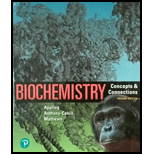
Concept explainers
Some anaerobic bacteria use alternative pathways for glucose catabolism that convert glucose to acetate rather than to pyruvate. Shown below is one possible
A → B + C (Enzyme 1) and
C → B + D. All the steps where ATP is consumed or generated have been shown; however, the addition or loss of NAD+/NADH, Pi,
H2O, or has not been shown explicitly. Draw the structures for the intermediates B, F, G, H, and l, and include other reaction participants as needed.
Want to see the full answer?
Check out a sample textbook solution
Chapter 12 Solutions
Biochemistry: Concepts and Connections (2nd Edition)
Additional Science Textbook Solutions
Human Physiology: An Integrated Approach (8th Edition)
Physics for Scientists and Engineers: A Strategic Approach, Vol. 1 (Chs 1-21) (4th Edition)
Introductory Chemistry (6th Edition)
Anatomy & Physiology (6th Edition)
Genetic Analysis: An Integrated Approach (3rd Edition)
Human Anatomy & Physiology (2nd Edition)
- From the reaction data below, determine whether the reaction is first order or second order and calculate the rate constant. Time (s) 0 Reactant (mM) 6.2 1 3.1 2 2.1 3 1.6 4 1.3 5 1.1 Only a plot of 1/[reactant] versus t gives a straight line, so the reaction is 0.150 mM-1 s-1 . S second order . The slope, k, isarrow_forwardFrom the reaction data below, determine whether the reaction is first order or second order and calculate the rate constant. Time (s) 0 Reactant (mM) 5.4 1 4.6 2 3.9 3 3.2 4 2.7 5 2.3 Only a plot of In[reactant] versus t gives a straight line, so the reaction is s-1. . The negative of the slope, k, isarrow_forwardA protein has a molecular mass of 400 kDa when measured by size-exclusion chromatography. When subjected to gel electrophoresis in the presence of sodium dodecyl sulfate (SDS), the protein gives three bands with molecular masses of 180, 160, and 60 kDa. When electrophoresis is carried out in the presence of SDS and dithiothreitol (DTT), three bands again form, this time with molecular masses of 160, 90, and 60 kDa. How many subunits does the protein have, and what is the molecular mass of each? four subunits: 180, 160, 90, and 60 kDa three subunits: 180, 160, and 60 kDa three subunits: 160, 90, and 60 kDa four subunits: 160, 90, 90, and 60 kDa Correct Answerarrow_forward
- Calculate KM and Vmax from the following data: KM= i Vmax [S] (μM) vo (mM.s-¹) 0.1 0.34 0.2 0.53 0.4 0.74 0.8 0.91 1.6 1.04 μM mM s-1arrow_forwardPropose a detailed chemical mechanism for the enzyme catalyzed reaction below and briefly note similarities, if any, to enzymes that we've studied. CO2 + CO2 2 CO2 HO CH3arrow_forwardState and describe the four stages of protein formation, please include the types of bonds at each stage.arrow_forward
- Please state and describe the four different types of non-covalent interactions.arrow_forwardPls help with these three questionsarrow_forward11. Which of the compounds below is the major product of the following reaction sequence? NOTE: PCC is pyridinium chlorochromate 1. BH 3 PCC 2. H2O2, NaOH NH HN ΗΝ, A B C CH3NH2, NaBH3CN D E NHarrow_forward
- 10. Which of the compounds below is the major organic product obtained from the following reaction sequence? Ph Ph Ph A B OH 1. EtMgBr H2CrO4 Zn(Hg), aq. HCI PhCHO ? 2. H₂O, H+ Ph. C D Ph "ར HO OH Earrow_forward7. What is the major organic product obtained from the following reaction sequence? Ph A OH 99 Ph OH D Br HOCH2CH2OH H2SO4 1. Mg, Et₂O 2. PhCH2CHO HCI, H₂O Br OH Ph Ph OH B C Br OH Ph Earrow_forwardPls helparrow_forward
 BiochemistryBiochemistryISBN:9781305577206Author:Reginald H. Garrett, Charles M. GrishamPublisher:Cengage Learning
BiochemistryBiochemistryISBN:9781305577206Author:Reginald H. Garrett, Charles M. GrishamPublisher:Cengage Learning Concepts of BiologyBiologyISBN:9781938168116Author:Samantha Fowler, Rebecca Roush, James WisePublisher:OpenStax College
Concepts of BiologyBiologyISBN:9781938168116Author:Samantha Fowler, Rebecca Roush, James WisePublisher:OpenStax College Human Physiology: From Cells to Systems (MindTap ...BiologyISBN:9781285866932Author:Lauralee SherwoodPublisher:Cengage Learning
Human Physiology: From Cells to Systems (MindTap ...BiologyISBN:9781285866932Author:Lauralee SherwoodPublisher:Cengage Learning Biology (MindTap Course List)BiologyISBN:9781337392938Author:Eldra Solomon, Charles Martin, Diana W. Martin, Linda R. BergPublisher:Cengage Learning
Biology (MindTap Course List)BiologyISBN:9781337392938Author:Eldra Solomon, Charles Martin, Diana W. Martin, Linda R. BergPublisher:Cengage Learning Human Heredity: Principles and Issues (MindTap Co...BiologyISBN:9781305251052Author:Michael CummingsPublisher:Cengage Learning
Human Heredity: Principles and Issues (MindTap Co...BiologyISBN:9781305251052Author:Michael CummingsPublisher:Cengage Learning





